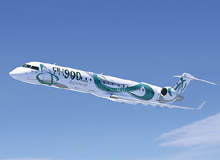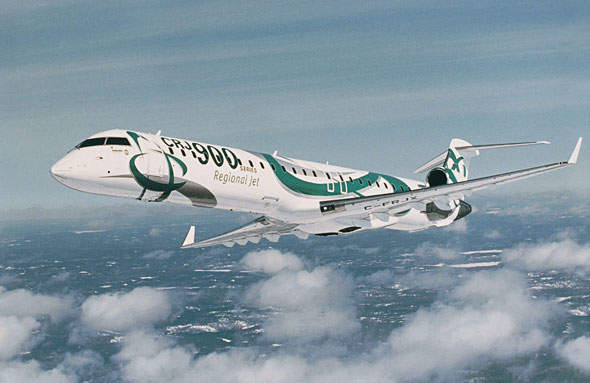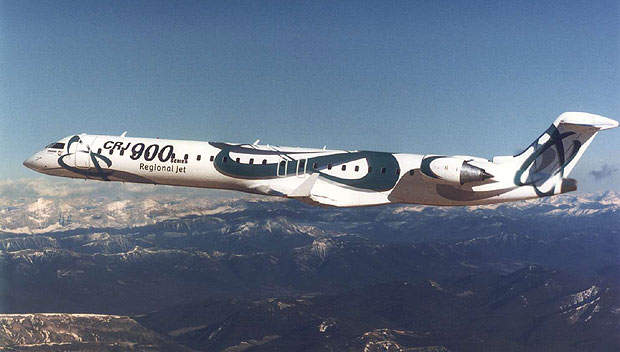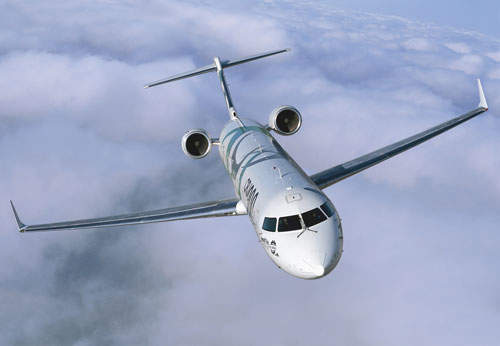The Bombardier CRJ900 regional jet, a stretched derivative of the CRJ700 was announced in 1999. The assembly of the first production aircraft began in 2001.
The aircraft completed its first flight on 21 February 2001 at Montreal’s Mirabel International Airport. In February 2003, the first aircraft was delivered to Mesa Airlines that placed firm orders for 25 aircraft.
There were 487 aircraft orders placed for the CRJ900 regional jet. A total of 438 were delivered by April 2019.
CRJ900 development
The aircraft has similar features with other members of the CRJ family. CRJ900 has common crew qualification (CCQ) with the CRJ200 and CRJ700, as well as a reconfigurable flight simulator, common maintenance and training procedures, spares and ground support equipment.
The 86-seat CRJ900 is a stretched variant of the 70-seat CRJ700 with two fuselage plugs, one forward and one aft of the centre section.
Compared with the CRJ700, the CRJ900 has 5% higher thrust engines, strengthened main landing gear, upgraded wheels and brakes, a strengthened wing, increased volume in the forward underfloor baggage hold, an additional underfloor baggage door and two additional overwing exits.
For fast airport turnaround, an additional service door was placed at the aft starboard side of the fuselage, providing access for aircraft cleaning and galley replenishment crew, while passengers leave through the forward passenger door.
In March 2005, Bombardier announced that it upgraded the CRJ900 by redesigning the wing-tip and winglet and optimising the wing’s leading-edge devices to provide lower lift / drag ratio and reduced-approach speeds. This resulted in improved payload range, take-off and landing performance and lower fuel costs.
Bombardier launched the Challenger 890, a corporate shuttle based on the CRJ-900, in May 2005. Challenger 890 accommodates 90 passengers in a standard cabin, 52 in a split cabin and 52 in deluxe cabin configuration. The aircraft entered service in February 2008 with Suncor Energy Inc of Calgary Canada.
In May 2007, Bombardier announced the CRJ NextGen family aircraft that have new cabin interiors, including larger passenger windows, additional baggage space and LED lighting.
American Airlines was the first customer to benefit from the latest CRJ900 NextGen regional jet as it reduces the 5.5% fuel burn reduction compared with the CRJ900 aircraft. The first CRJ900 NextGen aircraft for American Airlines was revealed in May 2014.
American Airlines placed a $1.14bn order for 24 CRJ900 NextGen aircraft in February 2015. In May 2018, the company placed a $719m order for 15 CRJ900 aircraft, with options for 15 additional aircraft. The carrier preferred PSA Airlines to operate its 15 new Bombardier CRJ900 NextGen aircraft under the American Eagle brand.
Resin transfer moulding (RTM) composites are being used more in aircraft construction with reduced fuel consumption.
The first NextGen aircraft, the 75 to 90 seat CRJ900 NextGen, entered service with Northwest Airlines in June 2007. It is the bestseller among the CRJ NextGen series. The 66 to 68-seat CRJ700 NextGen entered service in 2009.
Bombardier CRJ900 orders and deliveries
Germany’s Deutsche Lufthansa placed a $317m order for eight CRJ900 NextGen aircraft in July 2010.
China Express Airlines confirmed a conditional order with Bombardier for six CRJ900 NextGen aircraft in February 2012. The order was finalised five months later. China Express Airlines placed an order worth $462.6m for the delivery of ten additional CRJ900 jets in December 2015.
Bombardier Aerospace received a firm order from Rwandair for two CRJ900 NextGen aircraft in March 2012. The first of two aircraft was delivered in October 2012.
Bombardier Aerospace received a $727m-worth firm order from an anonymous customer for 16 CRJ900 NextGen aircraft in June 2014. The order included options for eight additional aircraft.
Macedonian airline and Tuninter own one Bombardier CRJ900 each, Petroleum Air Services, Tatarstan and RwandAir own two CRJ900s each, Atlasjet and Estonian Air own three CRJ900s each, My Way airlines and Arik Air have four CRJ900s each, Adria Airways owns six, while Libyan and Lufthansa own eight CRJ900 aircraft each.
CityJet and Air One own ten CRJ900s each, while SAS Scandinavian Airlines, Trident Jet and Lufthansa CityLine own 12 aircraft each.
Air Nostrum owns 11 aircraft, Pluna airlines owns 13 CRJ900s, Lufthansa / Eurowings has 15 CRJ900s, SkyWest owns 21 CRJ900s, Northwest Airlines owns 36, China Express owns 38 and Mesa owns 45 CJR900 aircraft.
Uganda Airlines placed orders for four aircraft, while Chorus Aviation ordered 14 aircraft in 2018. The first two aircraft were delivered to Uganda Airlines in April 2019.
American Airlines placed orders for 69 aircraft, of which 54 were delivered, and CIB Leasing placed orders for five CRJ 900 aircraft. Delta Connection received 44 Bombardier CRJ 900 aircraft, while Delta Air Lines placed orders for 60 aircraft, of which 48 were delivered.
In June 2018, Delta agreed with Bombardier to buy 20 CRJ900 aircraft to replace the ageing regional jets operated by Delta Connection. An undisclosed customer placed orders for six CRJ-900 aircraft. Uganda National Airlines Company placed an order for four Bombardier CRJ 900 jets. Jazz Aviation, a subsidiary of Chorus Aviation, finalised an order for nine CRJ-900 aircraft in February 2019. Deliveries are scheduled in the first half of 2020.
CRJ900 variants
The CRJ900 has a range of 2,956km, while its long-range version named CRJ900LR has a range of 3,385km with a full passenger load.
The CRJ900ER European was designed for services to European airports. The aircraft has a reduced maximum take-off weight (36,995kg compared with 37,421kg for the CRJ900ER) to reduce the weight-sensitive charges at European airports.
Bombardier CRJ900 flight deck
The two-pilot flight deck is fitted with a Rockwell Collins Pro Line 4 six-tube Electronic Flight and Information System (EFIS) and an Engine Indication and Crew Alerting System (EICAS). The instrument panel has six 127mm x 178mm (5in x 7in) cathode ray tube displays.
The aircraft is equipped with a Flight Dynamics HGS 2000 head-up display and guidance system, a Rockwell Collins automatic heading reference system (AHRS), terrain collision avoidance system (TCAS) and Rockwell Collins digital weather radar. The integrated avionics processor has autopilot and flight management systems.
The windscreen and cockpit side windows are fitted with electric de-icing systems.
CRJ900 cabin
The fuselage is of semi-monocoque design. The main cabin by C&D Interiors is approximately 21.6m-long with a centre-line width of 2.13m and the capability to seat up to 90 passengers. Standard seating is for 86 passengers with seats at 31in (78.7cm) pitch in a four-abreast configuration. Other interior layouts include two-class interiors with a mixed-seat pitch. The aircraft’s lighting is supplied by Hella Aerospace.
The rear baggage and an underfloor compartment provide a total baggage space of 25.17m³. The cabins are air-conditioned by a Liebherr air management system. GKN manufactured the tail cone and doors.
Bombardier introduced the atmosphere cabin design at the Farnborough International Air Show held in the UK in July 2018. The new design offers additional passenger space, a wider aisle, larger windows and more cabin connectivity options. The wheel-first roller bag facility offers 50% additional capacity.
CRJ900 engines
The aircraft is powered by two General Electric CF34-8C5 turbofan engines fitted with full authority digital engine control (FADEC). They provide 58.4kN thrust at take-off. The engine nacelles, supplied by Bombardier Aerospace (Shorts Brothers) of Belfast are mounted on the fuselage rear section sides.
There are two integral wing fuel tanks with a fuel capacity of 11,148l. The Intertechnique fuel management system is fitted with Ratier-Figeac controls. The maximum usable fuel load is 8,823kg.
A Honeywell auxiliary power unit is installed in the tail cone. Hamilton Standard electrical generator with two integrated drive generators provides 40kVA of electrical power.
Landing gear
The aircraft is fitted with Menasco Aerospace retractable tricycle-type landing gear. Bombardier CRJ900 landing gear is strengthened and fitted with upgraded wheels and brakes compared with the CRJ700 to be compatible with higher operating weights.






